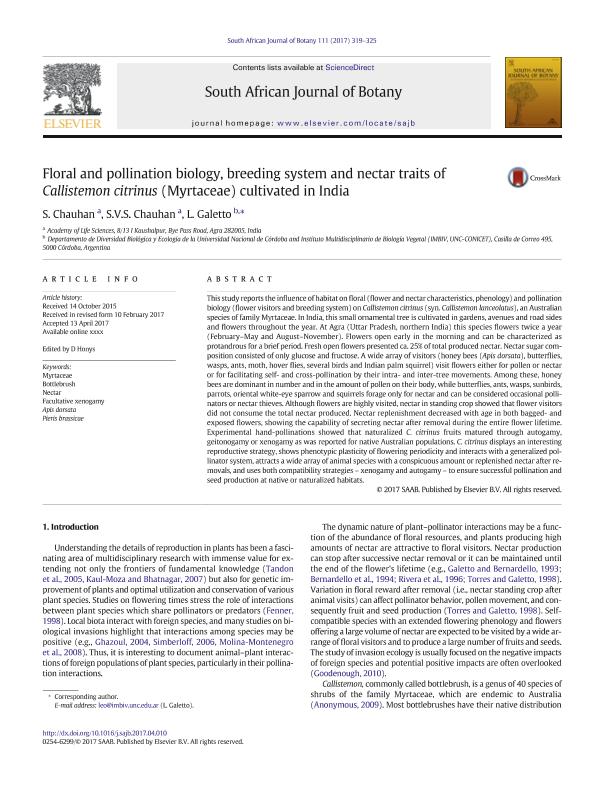Mostrar el registro sencillo del ítem
dc.contributor.author
Chauhan, S.
dc.contributor.author
Chauhan, S. V. S.
dc.contributor.author
Galetto, Leonardo

dc.date.available
2017-07-12T18:28:57Z
dc.date.issued
2017-04
dc.identifier.citation
Chauhan, S.; Chauhan, S. V. S.; Galetto, Leonardo; Floral and pollination biology, breeding system and nectar traits of Callistemon citrinus (Myrtaceae) cultivated in India; Elsevier Science; South African Journal Of Botany; 111; 4-2017; 319-325
dc.identifier.issn
0254-6299
dc.identifier.uri
http://hdl.handle.net/11336/20239
dc.description.abstract
This study reports the influence of habitat on floral (flower and nectar characteristics, phenology) and pollination biology (flower visitors and breeding system) on Callistemon citrinus (syn. Callistemon lanceolatus), an Australian species of family Myrtaceae. In India, this small ornamental tree is cultivated in gardens, avenues and road sides and flowers throughout the year. At Agra (Uttar Pradesh, northern India) this species flowers twice a year (February–May and August–November). Flowers open early in the morning and can be characterized as protandrous for a brief period. Fresh open flowers presented ca. 25% of total produced nectar. Nectar sugar composition consisted of only glucose and fructose. A wide array of visitors (honey bees (Apis dorsata), butterflies, wasps, ants, moth, hover flies, several birds and Indian palm squirrel) visit flowers either for pollen or nectar or for facilitating self- and cross-pollination by their intra- and inter-tree movements. Among these, honey bees are dominant in number and in the amount of pollen on their body, while butterflies, ants, wasps, sunbirds, parrots, oriental white-eye sparrow and squirrels forage only for nectar and can be considered occasional pollinators or nectar thieves. Although flowers are highly visited, nectar in standing crop showed that flower visitors did not consume the total nectar produced. Nectar replenishment decreased with age in both bagged- and exposed flowers, showing the capability of secreting nectar after removal during the entire flower lifetime. Experimental hand-pollinations showed that naturalized C. citrinus fruits matured through autogamy, geitonogamy or xenogamy as was reported for native Australian populations. C. citrinus displays an interesting reproductive strategy, shows phenotypic plasticity of flowering periodicity and interacts with a generalized pollinator system, attracts a wide array of animal species with a conspicuous amount or replenished nectar after removals, and uses both compatibility strategies – xenogamy and autogamy – to ensure successful pollination and seed production at native or naturalized habitats.
dc.format
application/pdf
dc.language.iso
eng
dc.publisher
Elsevier Science

dc.rights
info:eu-repo/semantics/openAccess
dc.rights.uri
https://creativecommons.org/licenses/by-nc-sa/2.5/ar/
dc.subject
Pollination
dc.subject
Reproductive Biology
dc.subject
Callistemon
dc.subject
Nectar
dc.subject.classification
Ecología

dc.subject.classification
Ciencias Biológicas

dc.subject.classification
CIENCIAS NATURALES Y EXACTAS

dc.title
Floral and pollination biology, breeding system and nectar traits of Callistemon citrinus (Myrtaceae) cultivated in India
dc.type
info:eu-repo/semantics/article
dc.type
info:ar-repo/semantics/artículo
dc.type
info:eu-repo/semantics/publishedVersion
dc.date.updated
2017-07-07T20:06:28Z
dc.journal.volume
111
dc.journal.pagination
319-325
dc.journal.pais
Países Bajos

dc.journal.ciudad
Amsterdam
dc.description.fil
Fil: Chauhan, S.. Academy of Life Sciences; India
dc.description.fil
Fil: Chauhan, S. V. S.. Academy of Life Sciences; India
dc.description.fil
Fil: Galetto, Leonardo. Consejo Nacional de Investigaciones Científicas y Técnicas; Argentina
dc.journal.title
South African Journal Of Botany

dc.relation.alternativeid
info:eu-repo/semantics/altIdentifier/url/http://www.sciencedirect.com/science/article/pii/S0254629915326120
dc.relation.alternativeid
info:eu-repo/semantics/altIdentifier/doi/https://doi.org/10.1016/j.sajb.2017.04.010
Archivos asociados
